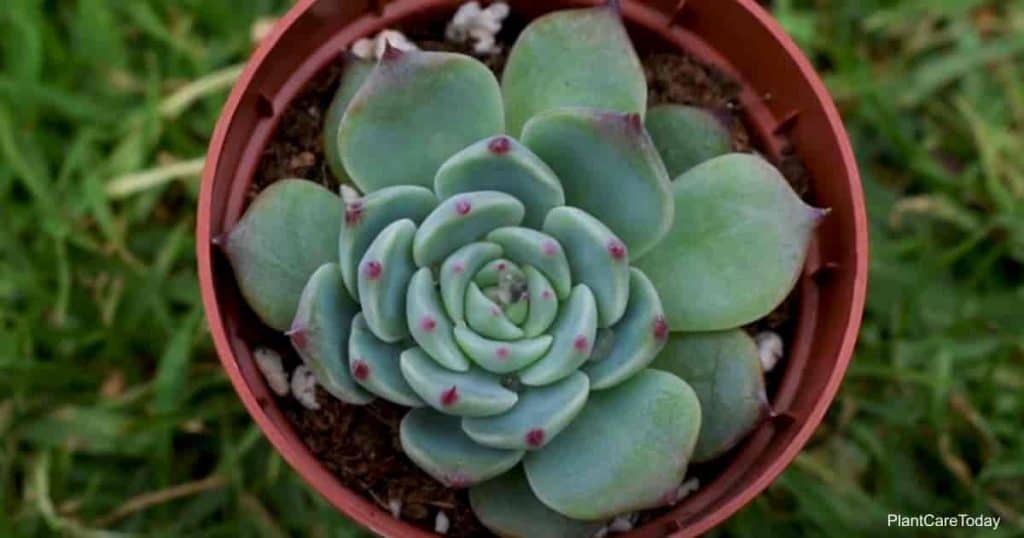Echeveria chihuahuensis (ech-eh-VER-ee-a chee-wah-wah-EN-sis) is a small and pretty member of the family Crassulaceae. Like all its cousins, it is often referred to as Hen and Chicks. It is also called Cats’ Claws.
This compact succulent Echeveria has thick, fleshy leaves are in a rosette formation. The leaves are bluish-gray in color with a bright pink tinge around the edges.

This perennial is a native of Chihuahua, Mexico in the Valley of the Rio Colorado. It thrives at an elevation of 2300 meters.
Echeveria Chihuahuaensis Care
Size & Growth
Rosette width is approximately 4″ inches. Under ideal conditions, the rosettes sprout “pups” and spread to form large clusters.
Leaves are teardrop-shaped and come to a very sharp point. It is this quality that gives the plant its common name, Cats’ Claws.
This video provides interesting information on Echeveria leaf shapes.
Echeveria Chihuahuensis Versus Echeveria Colorata, Telling Them Apart
Flowering & Fragrance
Flowers are a lovely shade of coral pink. They stand above the rosette on fleshy flower stalks.
If kept outdoors, the pretty, lightly scented flowers attract bees and hummingbirds.
Light & Temperature
This Echeveria grows well outdoors in a full sun setting. This succulent is winter hardy in USDA hardiness zones 9B through 11 B.
Chihuahuensis do well at temperatures ranging from 65° to 80° degrees Fahrenheit. During the fall and winter, 55° to 75° degrees Fahrenheit is best.
When grown as a houseplant, move your Echeveria to a slightly cooler (but bright) setting during the wintertime.
Watering and Feeding
Water Echeverias as you would other types of succulents using the soak-and-dry method. Allow the soil to become almost completely dry and then water from below to saturate the soil.
Take care not to get the leaves wet. Do not leave your Echeveria sitting in water for longer than fifteen or twenty minutes.
Reduce watering in the wintertime. Year-round, all varieties of Echeveria succulents like about 40% humidity.
These succulents seldom need fertilizing. If kept in a fresh soil mixture, they should get all the nourishment they need from the soil.
If you do decide to fertilize, do so during the growing season. Fertilize with a diluted mixture of liquid fertilizer with an NPK ratio of 2-7-7.
Soil and Transplanting
As with all succulents and cactus, provide a well-draining soil mix.
A commercial cactus or succulent mix is fine. Create your own mix with a half-and-half combination of high-quality potting soil, coarse sand and/or fine gravel.
Grooming & Maintenance
Take care when handling your Echeveria as the leaves may easily fall off.
If this happens, don’t despair! Every single leaf will grow into a full-grown plant if given half a chance.
How To Propagate Echeveria Chihuahuaensis
It is possible to propagate Chihuahuensis Echeveria from seed. It is much easier to lay a leaf on the surface of well-draining soil and let nature take its course.
- Set leaf cuttings set in a warm setting with bright, indirect sunlight.
- Mist occasionally
- Wait for roots to sprout naturally
- Enjoy growing into new larger plants
The mother plant may also produce offsets (chicks) that can be separated and planted in their own pots.
Echeveria Chihuahuaensis Pest or Disease Problems
As with most succulents, the main problem root rot caused by overwatering.
- Allow the soil to dry almost completely between waterings.
- Never allow the plant to stand in water.
- Avoid overhead watering.
When kept as a houseplant, most succulents are subject to pests such as woolly aphids.
Control these small, furry, teardrop-shaped white bugs with an insecticidal soap recipe or a Neem oil spray.
Separate affected plants from your other houseplants to avoid spreading the pests. Learn more about Echeveria diseases and pests.
Is Echeveria Chihuahuaensis Toxic or Poisonous?
All Echeveria are non-toxic, but remember that they are ornamental plants. Eating them is not advisable.
Is Chihuahuaensis Echeveria Considered Invasive?
Under ideal conditions, Echeverias could spread and form large clumps over time. They are not fast-moving and are not considered invasive in any setting. [source]
Suggested Echeveria Chihuahuaensis Uses
These cheery succulents do well indoors or outdoors with plenty of sun, warm temperatures, and good air circulation.
Chihuahuaensis makes a nice addition to the rock garden, sun porch, or warm, sunny window sill.
Mixed with other succulents, they make a delightful addition to a dish garden.
Keep Exploring The World Of Echeveria and Succulents
Add Chroma Echeveria if you want to add some color to your garden. It’s a perfect choice! Our guide will show you how to grow and care for this beautiful succulent.
Echeveria Lola Care: A must-have plant for any desert or dry garden! We share growing and care details for this drought-resistant beauty. Make it a part of your collection and check out our guide.
